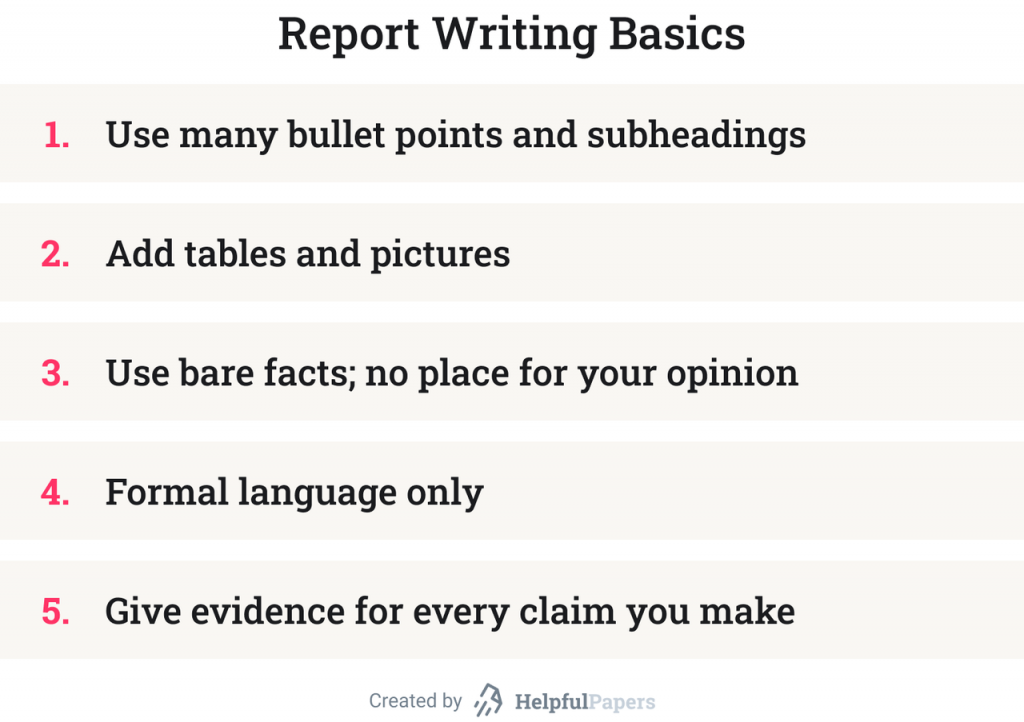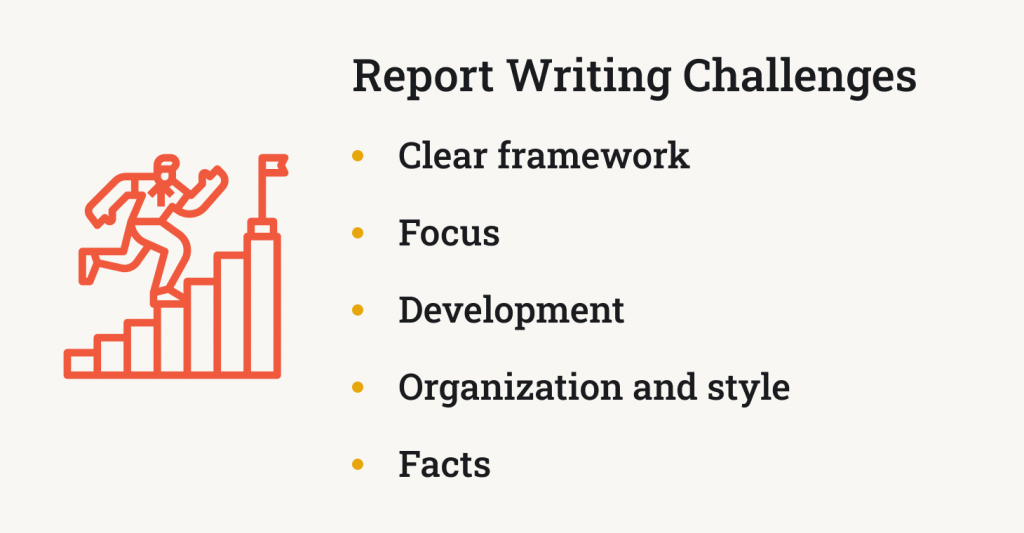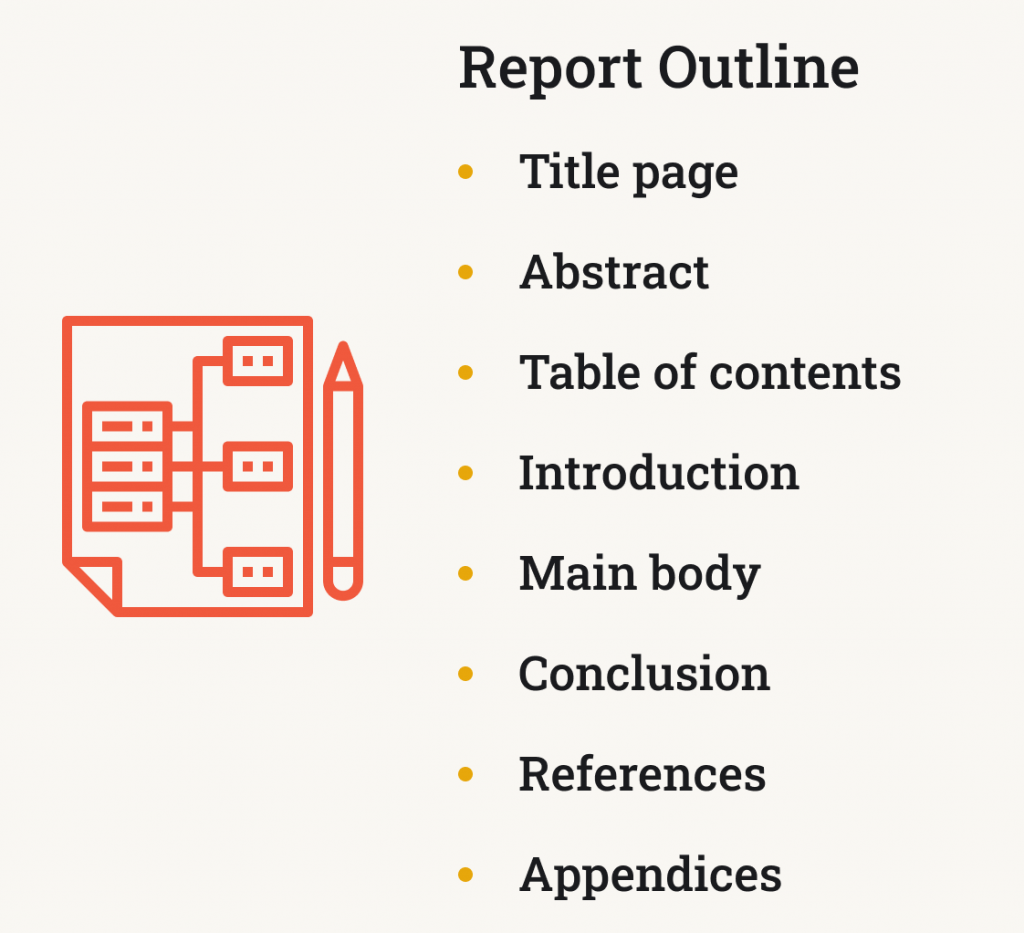All students go through this, sooner or later. Report writing is like an initiation into college. You are not a real student until you squeeze out at least one report.
That’s why we recommend you learn the main report-building rules to save time in the future.

These are general principles to know when you have the assignment to write a report. From the aspects mentioned above, you can already feel the character and style of a report.
It is straightforward, clearly structured, and prosperous for facts. Therefore, reports are mostly suitable for business, natural sciences, medicine, and other scientific areas.
Ready to learn more?
Great!
Here you can find a detailed explanation of report writing rules, purposes, and structure. Special attention is paid to different types of reports; also, don’t miss excellent tips on report presentation.
Let’s go! 👉👉
🧱 What Is a Report?
Simply put, a report is a statement. It is a proposition/analysis that informs the audience about a particular subject.

One detail that we would add to the Cambridge definition – a report can also describe an issue or an object.
Depending on a research area and subject, the content of a report varies, and so does its nature. However, regardless of your topic, a report should represent some information based on collected and analyzed data. That is, while working on a report, pay very distinct attention to the evidence that supports your words.
Here are the crucial features of any report:
- A report is structured and easy to follow
- A report analyzes the issue
- A report presents facts and findings
- A report has a particular purpose and audience
- A report suggests recommendations on an issue
This list is only the beginning of what we are going to tell you further.
Let’s see what the essential requirements of report writing format are.
Challenges of Building a Report
Before you start writing your report assignment, it is constructive to figure out what its challenges are.
These are the aspects that a good report should meet—all of them.
- A clear framework. With the help of a framework, you refer to the question and stay within a defined scope. Having a rigorous pattern is crucial since you’ll be addressing many related terms and issues in the course of the report. However, your task is not to deepen into those questions and stick to your plan.
- Focus. Coming from the previous point, here, the discussion is about having a distinct central thought/idea. No high-quality report has a vague research focus. Remember that you are expected to discuss and solve an exact question within an exact framework.
- Development. This aspect requires you to make your work fluent and smooth. Control the logical connections between paragraphs and make sure that the topic is not just dryly retold. Rather, disclose the issue like you tell a story.

- Organization and style. A good report requires a lucid organization with subsections and logically structured content. Besides that, make sure to follow one style, both writing and formatting. It says about good manners and respect for your reader.
- Facts. Although a report can contain personal points of view, its core should be based on relevant, checked information. Seek the evidence and examples from authoritative sources and build up your logic on it.
Types of Report Writing
All reports have standard features like rigorous structurization, the importance of valid data, and intense language formality.
Now let’s figure out the classification of types of reports. This section will review some main types of report writing, their peculiarities, and aspects requiring special attention.
Lab Report
A lab report is a description of an experiment or any other kind of laboratory work that you have conducted. Therefore, the purpose of a lab report is to tell what, how, and why you have done it. Also, a lab report requires describing findings and their significance thoroughly.
Be able to explain all the terms you use in work, all the procedures, and results. An excellent understanding of the topic is necessary for a successful report.
Business Report
A business report serves as a company tool to help in decision-making processes. There are various types of business reports used for different purposes. For example:
- Recommendation report
- Investigative report
- Research studies report
- Periodic report
- Situational report
and other…
Research Report
A research report can be written on any subject. Many classes will require you to write a report on a research project you’ve conducted. Your main goal is to make it clear and comprehensive so that a reader understands each step.
Book Report
Unlike a book review, a book report centers on the overall summary: the plot, characters, main thoughts of a book, etc. That is to say, a book report is a brief retelling that refers to the key points and characters. Accordingly, a book report structure differs a lot from a research or business report structure, but about that later.
📑 Report Outline with Example
As we already mentioned, it is hard to create one universal outline for all types of reports. They all vary according to their logic and individual requirements. However, it is still possible to draw a list of points vital for a good report.
One thing that is 100% universal – rich, fruitful academic language. Lucky you! We have a fantastic compilation of analytical words & phrases for any purpose. Don’t hesitate to borrow some cool writing ideas from our article.
Now,
let’s see what a common content outline of a report is.
Title Page of a Report
Main parts: header with the short title of the report or your last name, depending on the citation style; the full title of the report, your name.
Tips and tricks:
- Follow the rules of the appropriate citation style;
- Consult your instructor or follow these title page examples.
Abstract
Main parts: a research question and main research findings; research methods used; conclusions and recommendations.
Tips and tricks:
- Keep it brief – up to 150-200 words.
- Don’t make references to the text of the actual report.
- Write it after completing the rest of the report writing.
Table of Contents in a Report
Main parts: headings and subheadings with their corresponding pages.
Tips and tricks:
- Include appendices and references in your table of contents;
- Don’t mention the abstract and title page.
Report Introduction
Main parts: background information, research question (or hypothesis), and significance of the chosen problem.
Tips and tricks:
- Avoid including too much background information – get to the point right from the start;
- Do your best to explain why your topic is important and why readers should care about it.
Main Body of a Report
Main parts: literature review, methodology, research findings, discussion, and limitations.
Tips and tricks:
- In a literature review, explore the different opinions on the question and point out a gap in the existing literature;
- When writing a report, choose a good research paper topic that genuinely interests you;
- In the research findings section, avoid analysis – simply write what you have found out;
- In the discussion paragraph, include a detailed analysis of your findings: make it the most prominent part of your paper;
- Remember that quality report writing is impossible without the review of limitations. Be sure to acknowledge that your research may have some drawbacks.
Conclusion
Main parts: a brief summary of all previous elements.
Tips and tricks:
- When writing reports, never include any new information in the conclusion part – repeat only what you have already said;
- Make it up to 10% of the total word count.
References in a Report
Main parts: all the sources used in your research (for text references, images, or tables).
Tips and tricks:
- Double-check that each of your in-text citations has a corresponding entry in the references section;
- Vice versa – make sure that every entry from the reference list has at least one in-text citation.
- When writing reports, don’t forget the alphabetical order and special rules for the works of the same author.
Appendices
Main parts: tables, graphs, pictures, questionnaires, etc.
Tips and tricks:
- Always write where you have borrowed something from (unless you have created it yourself).
- Filed experts will probably read appendices as they seek all technical details.
- Order appendices as they appear in the text.

Report Outline Example
Now, let’s look at the report outline example! You can check the full report here: An Urban Health Profile Report on Childhood Obesity. It describes a project that aimed to assess which elements of the urban environment could contribute to the high level of child obesity in the Hendon suburb, located in the London Borough of Barnet.
- Introduction.
The introduction briefly outlines what the report is about. It includes the background of the problem, the research purpose, and the preview of the sections included in the report. - Main body.
The main body of the report consists of 2 main sections:- Background. This section contains a literature review, demonstrating the author’s understanding of the academic literature and showing a critical evaluation of the material.
- Observation data and analysis. This section discusses the work done and the data obtained. The author has supported the findings with photos of the urban environment under evaluation.
- Recommendations and conclusions.
This section summarizes the main findings of the research and provides recommendations. In particular, the author suggests banning parking on pavements to promote walking and cycling. - References.
The reference list contains all the sources the author used in the research. These include scholarly articles and government publications.
🧪 Lab Report Writing Format
As already mentioned before, in a lab report, you need to describe every detail step-by-step. A good lab report consists of a thorough description of research goals, methods, procedures, findings, and results.
A lab report is mostly used in natural sciences, for example, physics, chemistry, biology, astronomy, etc.
Below are parts of a lab report you should consider.
- Title Page. Use a title that comprehensively characterizes your lab work focus.
- Abstract. Sketch your goals, questions, and findings in a brief paragraph at the beginning.
- Introduction. Refer to the background and key theories, including your hypothesis and objectives.
- Methods. Depict equipment, procedures, and materials, including all calculations and obstacles.
- Results. Introduce your findings visually. Discuss results based on these visualizations.
- Discussion. Sum up the results, refer to the hypothesis, and theorize your findings.
- Conclusion. Revise key points, relate to the problem, and note the significance of the research.
- References Section. Make a one-style list of all sources used.
- Appendices. Include all the materials that were too detailed to include in the main body.
These were the parts most likely to be required for your lab report.
Remember that if you follow thorough guidelines and do everything step-by-step, chances for success are way higher.
Now let’s quickly see lab reports on different subjects. What are their specificities?
🧲 Physics Lab Report Writing Format
The above-described structure is suitable for a physics lab report format. Your main goal in this piece of paper is to demonstrate how well you understand every step of work and its results.
To make your job easier, here is a great checklist. Go through these questions several times while writing a physics lab report.
- Will your friend or any random person be able to read your report and understand everything precisely? In other words, is it graspable for the masses?
- Will a person from your field be able to understand what you have done by just reading an abstract?
- Will you understand your lab report in a couple of months and repeat or thoroughly explain all the steps?
These questions will help you a lot in deciding what to include or exclude in your work.
We have only left to show you excellent examples of a physics lab report format, and we wish you luck!
Check out these:
- Hooke’s Law and a Simple Spring. Here is a report on experiments conducted to find the spring constant of a steel spring. The paper contains detailed instructions on building a report and its formatting.
- The Speed of Sound (p.69). An example of a lab report on the topic “The Speed of Sound.” In this physics lab report, you can find a well-written text and some drawbacks discussed in the end. Use this helpful analysis to avoid similar mistakes.
- Determination of the Spring Constant and Natural Frequency of Bungee Cord for Varying Applied Load (p.25). This is a well-designed physics lab report that researches how a bungee cord springs constantly changes by different loads. Pay attention to interpretations of all figures and tables, as well as how visually straightforward calculations are.
⚗️ Chemistry Lab Report Writing Format
Frankly speaking, there’s no significant difference in chemistry and physics lab report formats. The outline is the same, goal and logic as well.
For a fantastic guide to a chemistry lab report format, check the following sources:
- Writing a Lab Report (Chemistry); Lewis University
- Guide for Writing a Lab Report – for chemistry and biochemistry students; Concordia University
- How to Write a Chemistry Lab Report: 14 Steps
💼 Business Report Writing Format
A business report is a flexible format that varies according to the purpose. With the help of business reports, people exchange information and make decisions. Thus, it is essential to be very careful with everything you include in your business report.
A significant difference from other types of reports is that in a business report, you can deviate from formal academic language. It means that the primary factor in business report writing is the audience—your language and style change by who your listeners are. However, don’t take it as a total freestyle, a report is a report, and you must follow the rules.
For wholesome guidelines on a business report outline, here are some good sources:
- How to Write a Formal Business Report (With Examples)
- How to Write a Business Report
- Business Reports Helpsheet; The University of Melbourne
- Structuring a Business Report
Another distinctive feature of a business report is its intention to persuade. Unlike the chemistry lab report format, the business paper provides active recommendations. Suggesting a new method or alternative strategy, a business report states why its solutions deserve attention.
We recommend you read this business report prepared by Southwest Texas State University students. Inside, you can find an effective structurization, relevant data, and sufficient interpretation of the findings.
👩🏫 Report Presentation
Once your report is written, you might be asked to present it. Let’s quickly go through the primary rules of how to make an excellent report presentation.
- First and foremost, make a very detailed and accurate plan. Remember a simple rule: the more you talk, the more mistakes you make. That is why having a thorough outline of what you are going to say is so essential. It will help you to always keep to the main ideas and messages. No need to deepen into calculation details and other technical components.

- Like any other presentation, a report presentation needs a clear structure. Luckily, you have already worked on it while writing. Your task is to present this structure to the audience and, more importantly, don’t switch between parts without smooth links. In other words, make sure that every element has a natural transition from the previous one. This will make your speech stable, fluent, and professional.
- Denote your goals from the very beginning. There is no need to explain that being clear about what you want is one of the critical factors in perceiving your speech. Once you know your aims for this presentation and broadcast them to the audience, the whole speech takes a different form and tone: confident, straightforward, and efficient.

- The way you open your report presentation is decisive for the whole performance. We won’t stop repeating that the right hook is the best solution for a strong opening. With the help of a hook, you will be able to catch the audience’s attention.
Don’t lose any second; read our excellent guide on writing successful hooks, with samples and explanations: Catchy Hooks: Guidelines, Ideas, Samples.
If you manage to make a really good hook, your listeners will think about it throughout the speech and maybe after.
Here are some additional materials that will help you to deal with report presentation preparations:
Done! You are now ready to build a report presentation.
It’s ok if now you feel that report writing is almost as easy as snapping your fingers
Use the tips above, complete your report as soon as possible, and finally, relax.
Good luck with your report writing 🍀
If you have any questions, post them below in the comments section 👇